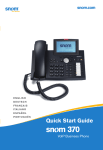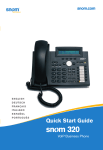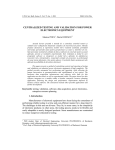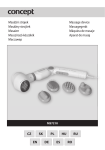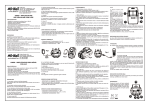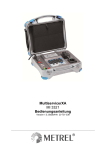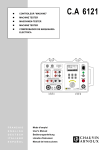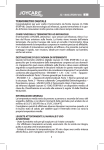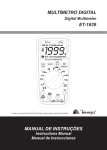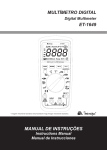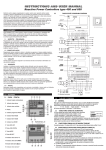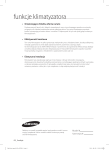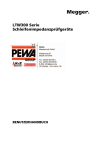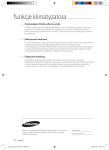Download Palm size digital multimeter MIE0141 MIE0142 - Uni-t
Transcript
Palm size digital multimeter MIE0141 MIE0142 Bedienungsanleitung DE Owner’s manual EN Instrukcja obsługi PL Manual de utilizare RO Bedienungsanleitung EINLEITUNG MIE0141/MIE0142 ist ein 3 ½ Anzeige Digital-Multimeter und folgenden Vorteilen: komplette Funktionen, neue Konfigurationen und hohe Zuverlässigkeit. Es ist für die Messung von AC / DC-Spannung, DC Strom, Widerstand, Induktivität, Temperatur, Dioden Vorwärtsspannungsabfall, Transistor, hFE und Kontinuität, bestimmt. Benutzen Sie den Multifunktionsstecker zur Messung von SMT. Diese Bedienungsanleitung enthält Sicherheitshinweise und Hinweise im Zusammenhang mit diesem Messgerät, die Bedienungsanleitung vor Gebrauch sorgfältig lesen und befolgen Sie streng alle Warnungen und Hinweise während der Bedienung. Warnung: Um einen elektrischen Schlag oder Verletzungen zu vermeiden, lesen Sie die “Sicherheitshinweise” und “Regeln für den sicheren Betrieb” sorgfältig, bevor Sie das Messgerät benutzen. REGELN FÜR SICHERE BEDIENUNG Warnung Zur Vermeidung von Stromschlag oder Verletzungen und um mögliche Schäden am Messgerät oder an der getesteten Schaltung zu vermeiden, sind folgende Regeln zu beachten: ● Bevor Sie das Messgerät benutzen, untersuchen Sie das Gehäuse. Verwenden Sie nicht das Messgerät, wenn es beschädigt ist oder das Gehäuse (oder einen Teil davon) entfernt ist. Achten Sie auf Risse oder fehlende Kunststoffteile. Achten Sie auf die Isolierung der Anschlüsse. DE ● Kontrollieren Sie die Messleitungen auf beschädigte Isolierung oder freiliegendes Metall. Überprüfen Sie die Messleitungen auf Durchgang. Ersetzen Sie beschädigte Messleitungen mit identischen Modell-Nummer oder elektrischen Spezifikationen, bevor Sie das Messgerät benutzen. 3 Bedienungsanleitung ● Überschreiten Sie nicht die auf dem Messgerät angegebene Nennspannung zwischen den Anschlüssen, bzw. zwischen den Anschlüssen und Erdung. Wenn der zu messende Wert unbekannt ist, verwenden Sie die maximale Messposition und verringern den Messbereich Schritt für Schritt, bis ein zufrieden stellender Messwert erreicht ist. ● Wenn die Messung abgeschlossen ist, trennen Sie die Verbindung zwischen den Messleitungen und der zu prüfenden Schaltung, entfernen Sie die Messleitungen von den Eingangsklemmen des Messgeräts und schalten das Messgerät aus. ● Der Drehschalter sollte in die richtige Position gebracht werden und keine Bereichumstellung darf während der Messung durchgeführt werden, um eine Beschädigung des Messgerätes zu verhindern. ● Keine Messung durchführen, wenn das Gehäuse des Messgerätes oder das Batteriefach nicht geschlossen sind, um Stromschläge zu vermeiden. ● Keine höhere Spannung als 600V zwischen den Eingangsklemmen des Messgeräts und der Erdung anlegen, zu einem elektrischen Schlag und Schäden am Messgerät zu vermeiden. DE ● Wenn das Messgerät mit einer effektiven Spannung über 60V Gleichstrom oder 30V rms Wechselstrom arbeitet, ist besondere Sorgfalt geboten, es besteht die Gefahr eines elektrischen Schlags. ● Verwenden Sie die richtigen Anschlüsse, Funktionen und Bereiche für die Messungen. ● Verwenden oder lagern Sie das Messgerät nicht in einer Umgebung mit hoher Temperatur, Feuchtigkeit, Explosionsgefahr, brennbaren Materialien und starkes Magnetfeld. Die Leistung des Messgeräts kann sich verschlechtern, nachdem aussetzen an Dämpfe. 4 Bedienungsanleitung ● Wenn Sie die Messspitzen verwenden, halten Sie Ihre Finger hinter dem Fingerschutz. ● Trennen Sie den Schaltkreis vom Strom und entladen Sie alle Hochspannungskondensatoren vor Widerstands-, Durchgangs- und Diodentest. ● Tauschen Sie die Batterie so bald die Batterie-Anzeige erscheint. Mit einer schwachen Batterie, kann das Messgerät falsche Messwerte anzeigen, die zu Stromschlag oder Verletzungen führen können. ● Bei der Wartung des Messgeräts, verwenden Sie nur das gleiche Modell Nummer oder Ersatzteile mit identischen elektrischen Spezifikationen. ● Die interne Schaltung des Messgeräts darf nicht verändert werden, um eine Beschädigung des Messgeräts und Unfälle zu vermeiden. ● Um die Oberfläche des Messgeräts reinigen verwenden Sie ein weiches Tuch und ein mildes Reinigungsmittel. Verwenden Sie keine Scheuer- und Lösungsmittel, um die Oberfläche des Messgeräts vor Korrosion, Beschädigungen und Unfälle zu schützen. ● Das Messgerät ist für den Innenbereich geeignet. ● Das Messgerät ausschalten, wenn es nicht in Gebrauch ist, und entnehmen Sie die Batterie, wenn es für eine lange Zeit nicht benutzt wird. DE ● Überprüfen Sie ständig die Batterie, da sie austreten kann, wenn es für längere Zeit nicht benutzt wurde, ersetzen Sie die Batterie so bald diese undicht wird. Eine undichte Batterie beschädigt das Messgerät. 5 Bedienungsanleitung MULTIMETERBESCHREIBUNG Abbildung 1 DE 1. LCD Display 2. Netztaste 3. Drehschalter 4. Eingangsbuchsen 5. Haltetaste 6 Bedienungsanleitung MESSVORGANG Überprüfen Sie zuerst die 9V Batterie, danach stellen Sie den Drehschalter auf den gewünschten Messvorgang. Bei schwacher Batterie erscheint im Display , Das Symbol an der Eingangsbuchse weist Sie darauf hin, nicht die maximale Eingangsspannung oder Eingangsstrom zu überschreiten. I. DC oder AC Spannungsmessungen (siehe Abbildung 2) 1) Drehschalter auf Position V~ oder V Spannungsmessung stellen. 2) Rote Messleitung in die “V” Buchse und schwarze Messleitung in die “COM” Buchse stecken und Messleitungen an die Testschaltung anlegen. Der Messwert wird am Display angezeigt, Wechselspannung wird als Effektivwert (rms) angezeigt. 3) In jedem Eingangsbereich hat das Multimeter eine Eingangsimpedanz von 10M . V~ Eingangsimpedanz ist etwa 4.5M . . Dieser Ladeeffekt kann einen Messfehler bei der Messung von Schaltkreisen mit hoher Impedanz hervorrufen. Wenn die Schaltkreisimpedanz kleiner oder gleich mit 10k , ist, ist der Fehler vernachlässigbar (0,1% oder kleiner). Warnung: • Um eventuell Schäden an dem Messgerät zu vermeiden, bitte nicht höhere Spannungen als 600V eingeben. • Um einen elektrischen Schlag zu vermeiden, seien Sie bitte vorsichtig bei der Hochspannungs-Messung. DE 7 Bedienungsanleitung Abbildung 2 II. DC Strommessungen (siehe Abbildung 3) 1) Drehschalter auf Position A Strommessung stellen. 2) Rote Messleitung in die “mA” oder“10A” Buchse und schwarze Messleitung in die “COM” Buchse stecken und Messleitungen an die Testschaltung anlegen. Der Messwert wird am Display angezeigt DE Warnung: • Voraussetzungen: Schalten Sie den Strom an der Testschaltung aus, bevor Sie das Multimeter anschließen, um das entstehen von Funken zu vermeiden. • Wählen Sie die richtige Eingangsbuchse und stellen den Drehschalter auf die zugehörige Messfunktion. Falls der Messwert unbekannt ist, wählen Sie den höchsten Messbereich aus und verringern diesen Schritt für Schritt, bis ein zufrieden stellender Messwert erreicht ist. 8 Bedienungsanleitung • Sicherungen befinden sich auf den mA und 10A Eingang. • Als Sicherheitsfunktion, sollte jede Messdauer weniger als 10 Sekunden betragen mit einer Pause von 15 Minuten zwischen den Messungen bei Strommessungen über 5A. Abbildung 3 DE 9 Bedienungsanleitung III. Widerstandsmessungen (siehe Abbildung 4) 1) Drehschalter auf Position “ ” Ohm-Messungen. 2) Rote Messleitung in die “ ” Buchse und schwarze Messleitung in die “COM” Buchse stecken und Messleitungen an die Testschaltung anlegen. Der Messwert wird am Display angezeigt. Warnung: • Das LCD Display zeigt „1” für offene Schaltung, oder der Messwiderstand ist höher als der maximale Messbereich des Multimeters. • Um Schäden am Messgerät oder Prüfschaltung zu vermeiden, trennen Sie den Schaltkreis vom Strom und entladen Sie alle Hochspannungskondensatoren vor Widerstandsmessung. • Für Messungen über 1M , dauert es normalerweise einige Sekunden mit kurzen Messleitungen um stabile Ergebnisse zu bekommen. • Um einen elektrischen Schlag und Schäden am Messgerät zu vermeiden, keine höhere Spannung als 60V DC und 30V AC am Messgerät anlegen. DE 10 Bedienungsanleitung Abbildung 4 IV. Diodentest (siehe Abbildung 5) 1) Drehschalter auf Position stellen. 2) Rote Messleitung in die Buchse und schwarze Messleitung in die “COM” Buchse stecken. Rote Messleitungen ist “+”schwarze Messleitung ist “-. 3) In einer Testschaltung erzeugt eine gute Diode einen Spannungsabfall von 500 ~ 800mV. Jedoch kann der Umgekehrte Spannungsabfall abhängig sein von dem Widerstand der anderen Verbindungen zwischen den Messspitzen. DE 11 Bedienungsanleitung Warnung: • Das LCD Display zeigt „1” für offene Schaltung, oder bei verkehrter Polarität. • Um Schäden am Messgerät oder Prüfschaltung zu vermeiden, trennen Sie den Schaltkreis vom Strom und entladen Sie alle Hochspannungskondensatoren vor Diodentest. • Um einen elektrischen Schlag und Schäden am Messgerät zu vermeiden, keine höhere Spannung als 60V DC und 30V AC am Messgerät anlegen. DE 12 Abbildung 5 Bedienungsanleitung V. Durchgangsprüfung (siehe Abbildung 6) 1) Drehschalter auf Position stellen. Buchse und schwarze Messleitung in 2) Rote Messleitung in die die “COM” Buchse stecken. Wenn zwischen den Messleitungen der Widerstand >70 , beträgt, ist die Schaltung offen und es ertönt kein Piepton. Bei einem Widerstand von 10 , zwischen den Messleitungen, ist ein Durchgang vorhanden und es ertönt ein Piepton. Der Widerstand der Testschaltung wird am Display angezeigt (Einheit ist ). Warnung: • Um Schäden am Messgerät oder Prüfschaltung zu vermeiden, trennen Sie den Schaltkreis vom Strom und entladen Sie alle Hochspannungskondensatoren vor Durchgangsprüfung. • Um einen elektrischen Schlag und Schäden am Messgerät zu vermeiden, keine höhere Spannung als 60V DC und 30V AC am Messgerät anlegen. DE Abbildung 6 13 Bedienungsanleitung VI. Transistor hFE Messung (siehe Abbildung 7) 1) Drehschalter auf Position “hFE” stellen. 2) Multifunktionsstecker in die Messbuchsen einstecken. 3) Überprüfen Sie den Transistor er ist entweder PNP oder NPN, montiert oder SMT, und schließen Sie dann den zu messenden Transistor an die entsprechenden Buchsen an 4) Im LCD Display wird der Referenzwert hFE angezeigt. Die Prüfungs-Voraussetzung: Basisstrom 10μA, Vce 2,3V. Warnung: • Um einen elektrischen Schlag und Schäden am Messgerät zu vermeiden, keine höhere Spannung als 60V DC und 30V AC am Messgerät anlegen. • Nach beenden der Messung Multifunktionsstecker entfernen. DE Abbildung 7 14 Bedienungsanleitung VII. Temperaturmessungen (nur für MIE0142), siehe Abbildung 8. 1) Drehschalter auf Position“0C”stellen. 2) Multifunktionsstecker in die Messbuchsen einstecken. 3) K—Type Punktkontakt-Messsonde kann nur für Temperaturmessungen unter 2300C verwendet werden, zur Messung von Temperaturen über 2300C muss eine separate Messsonde gekauft werden. 4) Im LCD Display wird “1” angezeigt wenn kein Kontakt mit der Messsonde besteht. Bei Kurzschluss zwischen den Messbuchsen wird Raumtemperatur angezeigt. Warnung: • Halten Sie die Punktkontakt-Messsonde rein um den Kontakteinfluss der Sonde zu verringern. • Nach der Messung Messsonde entfernen und gut aufheben. DE Abbildung 8 15 Bedienungsanleitung VIII. Batterietest (nur MIE0141), siehe Abbildung 9. 1)Drehschalter auf Position 1,5V oder 9V stellen. Buchse und schwarze Messleitung 2) Rote Messleitung in die in die “COM” Buchse stecken. Rote Messleitung ist “+”, schwarze Messleitung ist “-”. Schließen Sie die Messleitungen an der zu testenden Batterie an, unter Beachtung der korrekten Polarität. Der angezeigte Wert ist die Spannung zwischen der Anode und Kathode der Batterie. 3) 1,5V Einstellung Trockenzelle Batterietest ≤1.5V Widerstandslast etwa für 15Ω; 9V Einstellung ist nur für nur für Trockenzellen Batterietest ≤15V Widerstandslast etwa für 1kΩ. Warnung: • Es wird Empfohlen die Batterie nicht lange angeschlossen zu lassen. Dieses verhindert ein vorzeitiges entladen der Batterie und verlängert ihre Funktionsdauer. • Um einen elektrischen Schlag und Schäden am Messgerät zu vermeiden, keine höhere Spannung oder Strom als angegeben am Messgerät anlegen. DE Abbildung 9 16 Bedienungsanleitung MESSGENAUIGKEIT Messgenauigkeit: ± (a% Messwert + b Anzeigestellen), garantiert für 1 Jahr. Betriebstemperatur: 230C ±50C; Relative Luftfeuchtigkeit: ≤75% R.H. 1. DC Spannung Bereich Auflösung Messgenauigkeit 200mV 0.1mV ±(0.5% + 2) 2V 1mV 20V 10mV 200V 100mV 600V 1V ±(0.8% + 2) ● Eingangsimpedanz: 10MΩ ● Maximale Eingangsspannung: 600V DC 2. AC Spannung Bereich Auflösung Messgenauigkeit 200V 0.1mV ±(1.2% + 3) 600V 1mV DE ● Eingangsimpedanz: etwa 4.5MΩ ● Frequenz: 45Hz ~ 400Hz ● Display: Effektivwert der Sinuswelle (Mittelwert) Jeder Messung gilt ab 5% des Bereichs als Referenz. ● Maximale Eingangsspannung: 600V AC. 17 Bedienungsanleitung 3. DC Strom Bereich Auflösung 2000μA 0.1mV Messgenauigkeit MIE0141 MIE0142 ±(1% + 2) 20mA 1mV 200mA 10mV ±(1% + 2) ±(1.2% + 2) --- 10A 100mV ±(2% + 5) ● Überladungsschutz: - mA Bereich: F2 Sicherung φ6x25mm, F 1A H 250V (CE) - 10A Bereich: F1 Sicherung φ6x25mm, F 10A H 250V (CE) Warnung: Bei Messstrom ≤5A kontinuierliche Messung ist erlaubt. Bei Messstrom >5A kontinuierliche Messung ist für die Dauer von weniger als 10 Sekunden erlaubt mit einer Pause von mehr als 15 Minuten dazwischen. 4. Widerstand DE Bereich Auflösung 200Ω 0.1Ω 2kΩ 1Ω 20kΩ 10Ω 200kΩ 100Ω 2MΩ 1kΩ 20MΩ 10kΩ ● Überladungsschutz: 250V AC oder DC 18 Messgenauigkeit ±(0.8% + 5) ±(1% + 5) Bedienungsanleitung 5. Temperaturmessungen (nur für MIE0142) Bereich Auflösung Messgenauigkeit -40 ~ -20 C ±(8% + 5) 0 > -20 ~ 00C ±4 10C > 0 ~ 100 C 0 ±(1% + 3) > 100 ~ 10000C ±(2.5% + 2) ● Überladungsschutz: 250V AC oder DC ● Mitgeliefertes Punktkontakt K Type Thermoelement kann nur bis 2300C Temperaturmessungen verwendet werden. 6. Batterietest (nur für MIE0141) Bereich Auflösung 1.5V 1mV 9V 10mV Messgenauigkeit ±(1% + 2) ● Überladungsschutz: 250V AC oder DC. ● 1,5V Bereich: Widerstandslast etwa für 15Ω. ● 9V Bereich: Widerstandslast etwa für 1kΩ. 7. Diode, Transistor, Durchgangsprüfung Funktion Bereich Diode Transistor Durchgangsprüfung hFE Auflösung Messgenauigkeit 1mV Anzeige des positiven Spannungsabfalls DE 1β 1Ω <1Ω kontinuierlicher Piepton ● Überladungsschutz: 250V AC oder DC. 19 Bedienungsanleitung WARTUNG UND SERVICE Warnung: Bevor Sie den Deckel des Messgerätes öffnen, stellen Sie sicher dass die Messleitungen von der Testschaltung und Messgerät getrennt sind und das Gerät ausgeschaltet ist. 1. Allgemeine Wartung • Regelmäßig reinigen Sie die Oberfläche des Messgeräts mit einem weichen Tuch und ein mildes Reinigungsmittel. Verwenden Sie keine Scheuer- und Lösungsmittel. • Bei abnormalen Verhalten des Messgerätes, dieses nicht mehr benutzen und zum Servicezentrum zurückschicken. • Zur Kalibrierung des Messgerätes wenden Sie sich an qualifiziertes Fachpersonal oder speziellem Servicezentrum. 2. Austausch der Batterie und Sicherung, siehe Abbildung 10. Warnung: Wenn im Display die Anzeige schwacher Batterie erscheint, muss diese ersetzt werden. Eine schwache Batterie führt zu Messfehlern. Technische Daten der Batterie: 9V BF22 oder NEDA 1604 oder 006P. DE 20 Vorgehensweise: (1) Gerät ausschalten und Messleitungen entfernen. (2) Mit einem Schraubenzieher die Schraube des Batteriedeckels herausnehmen. Nun kann die Batterie ersetzt werden. (3) Mit einem Schraubenzieher zwei Schrauben herausnehmen. Nun kann die durchgebrannte Sicherung(en) ersetzt werden. Technische Daten der Sicherungen: - F1 Sicherung φ6x25mm, F 10A H 250V - F2 Sicherung φ6x25mm, F 1A H 250V Bedienungsanleitung Abbildung 10 Die Spezifikationen können ohne Ankündigung geändert werden. DE 21 Owner’s manual OVERVIEW MIE0141/MIE0142 multimeter is a hand-held 3 1/2 digital display digital multimeters with advanced design, multiple entire functions, novel figurations and reliable performance. This meter is fully capable to measure voltage both AC and DC, DC current, resistance, inductance, temperature and forward voltage drop of diode, transistor, hFE and continuity test etc. Please use multi-purpose socket to measure SMT as well. This operating manual covers information on safety and cautions to fulfill CE mark standard. Please read the relevant information carefully and observe all the warnings and notes strictly. Warning: To avoid electric shock or personal injury, read the “Safety information” and „Rules for Safe Operation” carefully before using the meter. RULES FOR SAFE OPERATION Warning To avoid possible electric shock or personal injury, and to avoid possible damage to the Meter or to the equipment under test, adhere to the following rules: EN ● Before using the Meter inspect the case. Do not use the Meter if it is damaged or the case (or part of the case) is removed. Look for cracks or missing plastic. Pay attention to the insulation around the connectors. ● Inspect the test leads for damaged insulation or exposed metal. Check the test leads for continuity. Replace damaged test leads with identical model number or electrical specifications before using the Meter. 22 Owner’s manual ● Do not apply more than the rated voltage, as marked on the Meter. ● When measurement has been completed, disconnect the connection between the test leads and the circuit under test and turn the Meter power off. ● The rotary switch should be placed in the right position and no any changeover of range shall be made during measurement is conducted to prevent damage of the Meter. ● Do not carry out the measurement when the Meter’s back case and battery compartment are not closed to avoid electric shock. ● When the Meter working at an effective voltage over 60V in DC or 30V rms in AC, special care should be taken for there is danger of electric shock. ● Use the proper terminals, function, and range for your measurements. ● Do not use or store the Meter in an environment of high temperature, humidity, explosive, inflammable and strong magnetic field. The performance of the Meter may deteriorate after dampened. ● When using the test leads, keep your fingers behind the finger guards. ● Disconnect circuit power and discharge all high-voltage capacitors before testing resistance, continuity and diode. ● Replace the battery as soon as the battery indicator appears. With a low battery, the Meter might produce false readings that can lead to electric shock and personal injury. EN ● When servicing the Meter, use only the same model number or identical electrical specifications replacement parts. 23 Owner’s manual ● The internal circuit of the Meter shall not be altered at will to avoid damage of the Meter and any accident. ● Soft cloth and mild detergent should be used to clean the surface of the Meter when servicing. No abrasive and solvent should be used to prevent the surface of the Meter from corrosion, damage and accident. ● The Meter is suitable for indoor use. ● Turn the Meter off when it is not in use and take out the battery when not using for a long time. ● Constantly check the battery as it may leak when it has been using for some time, replace the battery as soon as leaking appears. A leaking battery will damage the Meter. EN 24 Owner’s manual THE METER STRUCTURE Diagram 1 1. LCD display 2. Power button 3. Rotary switch 4. Input terminals 5. Hold button EN 25 Owner’s manual MEASUREMENT OPERATION First check on 9V battery, then turn rotary switch to the measursign will be displayed on LCD ing position. lf the low battery, panel. Nearly to sign on the meter front panel terminal input which alarm not exceed the testing voltage and current input value limitation. I. DC or AC voltage measurement (see diagram 2) 1) Turn rotary switch to V~ or V voltage measurement. 2) Insert the red test lead into the “V” terminal and the black test lead into the “COM” terminal, connect the lest leads across with the object being measured. The measured value shows on the display AC voltage measurement shows on true root mean square value stability period. 3) In each range, the meter has an input impedance of 10M . V~ input impedance is about 4.5M . This loading effect can cause measurement errors in high impedance circuits. If the circuit impedance is less than or equal to 10k , the error is negligible (0.1% or less). Warning: • To avoid possibly damages to the meter, please do not attempt to input higher than 600V. • To avoid electrical shock, please pay attention during the high voltage measurement. EN 26 Owner’s manual Diagram 2 II. DC current measurement (see diagram 3) 1) Turn rotary switch to A current measurement. 2) Insert the red test lead into the „ mA” or ”10A” terminal, and the black test lead into the „COM” terminal, Connect the test leads across with the object being measured. The measured value shows on the display. EN Warning: • Pre-requisites: Turn off power to the circuit before the connection between the test leads across with the object being measured. • Selecting the correct terminal input and turn the rotary switch to select the measuring function. In case of no any idea on the value input of the current, just simply test from the high value to low one. 27 Owner’s manual • Fuses are located on mA and 10A terminal input. Never attempt the test lead connect to any circuits especially on the power supply terminal and may be hurt. • For the safety purpose, less than 10 seconds is for each measurement duration and keep 15 minutes duration for next measurement during the current measurement over 5A. Diagram 3 EN 28 Owner’s manual III. Resistance measurement (see diagram 4) 1)Turn rotary switch to “ ” ohm measurement. 2) Insert the red test lead into the “ ” terminal and the black test lead into the “COM” terminal. Connect the test leads across with the object being measured. The measured value shows on the display. Warning: • The LCD displays „1” indicating open-circuit for the tested resistor or the resistor value is higher than the maximum range of the meter. • To maintain the resistance measurement accuracy, discount circuit power and discharge all the high voltage capacitors during the measuring resistance. • For high-resistance measurement greater than 1M , it is normal to take several seconds to obtain a stable reading with short test leads for measurement. • Do not input higher than DC 60V and AC 30V voltage to prevent any damage and accident. EN 29 Owner’s manual Diagram 4 IV. Diodes measurement (see diagram 5) EN 30 1)Turn rotary switch to . 2) Insert the red test lead into the terminal and the black test lead into the “COM” terminal. Red test lead is “+” Black test lead is “-”. 3) In a circuit, a good diode should still produce a forward voltage drop reading of 500~800mV. However, the reverse voltage drop reading can vary depending on the resistance of other pathways between the probe tips. Owner’s manual Warning: • The LCD displays “1” indicating open-circuit for the tested diodes or the testing the diodes with polarity. • To maintain the diodes measurement accuracy disconnect circuit power and discharge all the high voltage capacitors during the measuring resistance. • Do not input higher than DC 60V and AC 30V voltage to prevent any damage and accident. Diagram 5 EN 31 Owner’s manual V. Continuity measurement (see diagram 6) 1)Turn rotary switch to . terminal and the black test lead 2) Insert the red test lead into the into the “COM” terminal. If between both terminals show resistance >70 , it is a short-circuit,no buzzer, but if between both terminals show resistances 10 , it is a good connection with continually buzzer. Resistance value on tested circuit display on LCD (Unit is ). Warning: • To maintain the diodes measurement accuracy disconnect circuit power and discharge all the high voltage capacitors during the measuring resistance. • Do not input higher than DC 60V and AC 30V voltage to prevent any damage and accident. EN Diagram 6 32 Owner’s manual VI. Transistor hFE measurement (see diagram 7) 1)Turn rotary switch to “hFE”. 2) Put the muItiple purpose socket into the terminal. 3) Check the transistor is either PNP or NPN, assembles or SMT, then connect the transistor to be measured to the corresponding jacks. 4) LCD display hFE reference value. The testing requirement: basic current 10μA,Vce for 2.3V. Warning: • To avoid damages to the Meter or to the devices under test, do not input any current over 60V DC or 30V AC. • Take off the multi-purpose socket after the measurement. EN Diagram 7 33 Owner’s manual VII. Temperature measurement (for MIE0142 onIy), see diagram 8. 1) Turn rotary switch to “0C”. 2) Put the multiple purpose socket into the correct terminal. 3) K—Type point contact temperature probe can only be used in the measurement below 2300C, if you want to measure over 2300C, you need to separately buy another temperature probe. 4) The LCD displays “1” indicating point contact temperature probe which take off. When short circuit between, terminal and COM terminal, the meter show the value of room temperature. Warning: • Maintain clean the point contact temperature probe and do not let the probe contact point to have any serious influence. • Take off and well keep the point contact temperature after the measurement. EN Diagram 8 34 Owner’s manual VIII. Battery test (MIE0141 onIy), see diagram 9. 1)Turn rotary switch to 1.5V or 9V. terminal and the black test 2) Insert the red test lead into the lead into the “COM” terminal. Red test lead is “+”, black test lead is “-”. Connect the test leads across with the battery being measured ensuring the polarity is correct. The measured value shows on the display, which is the voltage between the cathode and anode of the battery. 3) 1.5V usage ≤1.5V dry cell battery test, resistance load is approximately for 15Ω; 9V is only suitable for ≤15V dry cell battery test, resistance load is approximately for 1kΩ. Warning: • Refuse to keep a long time connection battery in the measuring process, it avoids to loss the battery energy, to reduce battery’s life. • Refuses to use in over the specification of the battery or the current test, in order to avoid damages the measuring appliance and endangers the personal safety! EN Diagram 9 35 Owner’s manual ACCURACY SPECIFICATION Accuracy: ± (a% reading + b digits) guarantee for 1 year Operating temperature: 230C ±50C Relative humidity: <75% 1. DC voltage Range Resolution Accuracy 200mV 0.1mV ±(0.5% + 2) 2V 1mV 20V 10mV 200V 100mV 600V 1V ±(0.8% + 2) ● Input impedance: 10MΩ ● Maximum input voltage: 600V DC 2. AC voltage EN Range Resolution Accuracy 200V 0.1mV ±(1.2% + 3) 600V 1mV ● Input impedance: about 4.5MΩ ● Frequency: 45Hz ~ 400Hz ● Display: effective value of sine wave (average value) each measurement is applicable from 5% of range as reference. ● Maximum input voltage: 600V AC. 36 Owner’s manual 3. DC current Range Resolution 2000μA 0.1mV Accuracy MIE0141 MIE0142 ±(1% + 2) 20mA 1mV 200mA 10mV ±(1% + 2) ±(1.2% + 2) --- 10A 100mV ±(2% + 5) ● Overload protection: - mA range: F2 fuse φ6x25mm, F 1A H 250V (CE) - 10A range: F1 fuse φ6x25mm, F 10A H 250V (CE) Warning: When ≤5A continuous measurement is allowed. When > 5A continuous measurement less than 10 seconds at an interval more than 15 minutes. 4. Resistance Range Resolution 200Ω 0.1Ω 2kΩ 1Ω 20kΩ 10Ω 200kΩ 100Ω 2MΩ 1kΩ 20MΩ 10kΩ Accuracy ±(0.8% + 5) EN ±(1% + 5) ● Overload protection: 250V AC or DC 37 Owner’s manual 5. Temperature measurement (for MIE0142 only) Range Resolution Accuracy -40 ~ -20 C ±(8% + 5) 0 > -20 ~ 00C ±4 10C > 0 ~ 100 C 0 ±(1% + 3) > 100 ~ 10000C ±(2.5% + 2) ● Overload protection: 250V AC or DC. ● Enclosed point contact K type thermocouple can only be used on less than 2300C temperature measurement. 6. Battery test (for MIE0141 only) Range Resolution 1.5V 1mV 9V 10mV Accuracy ±(1% + 2) ● Overload protection: 250V AC or DC. ● 1.5V range: resistance load is about 15Ω. ● 9V range: resistance load is about 1kΩ. 7. Diode, transistor, continuity test Function EN Range Diode Transistor Continuity test hFE Resolution Accuracy 1mV Display positive voltage decline 1β 1Ω ● Overload protection: 250V AC or DC. 38 <1Ω buzzer beep continuously Owner’s manual MAINTENANCE AND SERVICE Warning: Make sure the test leads take off the terminal and the circuit as well as power off the meter if want to open the meter cover. 1. General service and maintenance • Periodically wipe the case with a damp cloth and mild detergent. Do not use abrasives or solvents. • Any abnormal on the meter, stop use the meter and return to service center. • When need to have calibration on the meter, please allow certified engineer or specific service center for the service maintenance. 2. Replacing the battery and fuse, see diagram 9. Warning: LCD display sign indicating battery will be run out and need to replace a new battery, if fail to do that. It causes the variance of the measuring result. Battery specification: 9V BF22 or NEDA 1604 or 006P Operating steps: (1) Turn the power in “off“ situation, then remove the test lead out of the meter. (2) Use screwdriver to take off the screw on the battery cover. Then you can take off old battery for replacing. (3) User screwdriver to take off two pieces of screws, then you can replacing the burned fuse(s) as replacement. Fuse specification: - F1 fuse φ6x25mm, F 10A H 250V - F2 fuse φ6x25mm, F 1A H 250V EN 39 Owner’s manual Diagram 10 Specifications are subject to change without notice. EN 40 Instrukcja obsługi WSTĘP MIE0141/MIE0142 z cyfrowym wyświetlaczem 3 1/2, charakteryzuje się dużą ilością funkcji, prostotą i wygodą użytkowania oraz niezawodnością działania. Miernik przeznaczony jest do pomiaru napięcia prądu stałego i zmiennego, natężenia prądu stałego, rezystancji, diod, ciągłości obwodu, hFE, temperatury (MIE0142), baterii (MIE0141) itp. Przed pierwszym użyciem miernika, należy dokładnie przeczytać instrukcję obsługi i stosować się do wszystkich zaleceń i informacji w niej zawartych. Instrukcję należy zachować w celu późniejszego wykorzystania. Uwaga: Aby uniknąć porażenia prądem elektrycznym, należy dokładnie i ze zrozumieniem przeczytać rozdział „Zasady bezpieczeństwa” oraz stosować się do zaleceń w nim zawartych. ZASADY BEZPIECZEŃSTWA Uwaga Aby uniknąć porażenia prądem elektrycznym lub innych uszkodzeń ciała, należy uważnie przeczytać i przestrzegać poniższych zasad: ● Przed użyciem miernika należy sprawdzić obudową, czy nie posiada uszkodzeń, jest zamknięta i skręcona wkrętami. ● Należy sprawdzić przewody pomiarowe, czy nie mają uszkodzeń izolacji. ● Nigdy nie wolno używać miernika, jeżeli napięcie płynące w mierzonym obwodzie jest wyższe niż maksymalne napięcie dla danego modelu miernika. PL 41 Instrukcja obsługi ● Po zakończonym pomiarze należy odłączyć przewody pomiarowe od mierzonego obiektu, odpiąć je od miernika i wyłączyć miernik. ● Obrotowy przełącznik powinien być ustawiony we właściwej pozycji przed dokonaniem pomiaru (nie należy go przekręcać w trakcie pomiaru). ● Nie należy używać miernika, jeżeli tylna obudowa i pokrywa baterii nie jest całkowicie zamknięta. ● Należy zachować szczególną ostrożność przy pomiarach, gdzie napięcie ma wartość powyżej 60V DC lub 30V AC. ● Należy dostosować położenie przełącznika obrotowego oraz sposób pomiaru do danego rodzaju pomiaru. ● Nie należy używać i przechowywać miernika w miejscach o dużej wilgotności powietrza, wysokiej temperaturze lub silnym polu elektromagnetycznym. ● Używając przewodów pomiarowych należy pamiętać, aby palce znajdowały się za osłoną ochronną. ● Należy wyłączyć zasilanie z mierzonego obwodu i rozładować wysokonapięciowe kondensatory przed pomiarem natężenia prądu, rezystancji lub przed sprawdzaniem diod. ● Baterię należy wymienić na nową niezwłocznie po pojawieniu się symbolu niskiego stanu naładowania baterii. ● Jeżeli podczas serwisowania miernika zachodzi konieczność wymiany elementu, to należy go wymienić na identyczny z oryginałem. PL ● Nie wolno dokonywać żadnych zmian wewnątrz miernika. ● Do czyszczenia obudowy miernika należy używać wyłącznie miękkiej ściereczki i delikatnego detergentu (nie należy stosować silnych środków czyszczących). 42 Instrukcja obsługi ● Miernik przeznaczony jest do użytku wewnątrz pomieszczeń. ● Po zakończeniu pomiarów, należy wyłączyć miernik. Jeżeli miernik nie będzie używany przez dłuższy okres czasu, należy wyjąć baterię zasilającą. ● Należy okresowo sprawdzać stan zainstalowanej baterii. Cieknąca bateria może spowodować uszkodzenie miernika. PL 43 Instrukcja obsługi OPIS MIERNIKA Diagram 1 PL 44 1. Wyświetlacz LCD 2. Przycisk Power (włączenie/wyłączenie miernika) 3. Przełącznik obrotowy 4. Gniazda wejściowe 5. Przycisk Hold Instrukcja obsługi WYKONYWANIE POMIARÓW W celu dokonania pomiaru, należy ustawić przełącznik obrotowy we właściwej pozycji (w zależności od rodzaju pomiaru) a następnie , nawłączyć miernik. Jeżeli na wyświetlaczu ukaże się symbol leży niezwłocznie wymienić baterię zasilania na nową. Nie należy dokonywać pomiarów w przypadku, gdy napięcie/natężenie prądu przekracza dopuszczalną dla miernika wartość. I. Pomiar napięcia DC lub AC (diagram 2) 1) Przełącznik obrotowy należy ustawić w pozycji V~ (prąd zmienny AC) lub V (prąd stały DC). 2) Czerwony przewód pomiarowy należy podłączyć do gniazda “V”, czarny do gniazda “COM”. Następnie należy podłączyć przewody pomiarowe do mierzonego obiektu i odczytać wynik pomiaru na wyświetlaczu. 3) W każdym zakresie miernik ma impedancję wejściową 10M . Przy pomiarze V~ impedancja wynosi około 4.5M . Może to powodować błędy pomiaru w obwodach wysokiej impedancji. Jeśli impedancja obwodu jest mniejsza lub równa 10k , błąd jest nieznaczny (0,1% lub mniej). Uwaga: • Aby uniknąć uszkodzenia miernika, nie należy dokonywać pomiaru, gdy wartość napięcia przekracza 600V. • Aby uniknąć porażenia prądem, należy zwracać szczególną uwagę podczas pomiaru wysokich napięć. PL 45 Instrukcja obsługi Diagram 2 II. Pomiar natężenia prądu DC (diagram 3) 1) Przełącznik obrotowy należy ustawić w pozycji A . 2) Czerwony przewód pomiarowy należy podłączyć do gniazda „mA” lub „10A”, czarny do gniazda “COM”. Następnie należy podłączyć przewody pomiarowe do mierzonego obiektu i odczytać wynik pomiaru na wyświetlaczu. PL Uwaga: • Przed rozpoczęciem pomiaru należy wyłączyć zasilanie mierzonego obwodu. • W zależności o mierzonej wartości należy wybrać odpowiednie gniazdo wejściowe oraz pozycję przełącznika obrotowego. W przypadku wątpliwości, należy sprawdzić wartości od najwyższej do najniższej. 46 Instrukcja obsługi • Bezpieczniki są zlokalizowane w gniazdach wejściowych mA oraz 10A. • Ze względów bezpieczeństwa, przy pomiarach natężenia prądu ponad 5A, czas trwania pomiaru nie powinien przekraczać 10 sekund z 15 minutowymi przerwami pomiędzy kolejnymi pomiarami. Diagram 3 PL 47 Instrukcja obsługi III. Pomiar rezystancji (diagram 4) 1) Przełącznik obrotowy należy ustawić w pozycji “ ”. 2) Czerwony przewód pomiarowy należy podłączyć do gniazda „ ”, czarny do gniazda “COM”. Następnie należy podłączyć przewody pomiarowe do mierzonego obiektu i odczytać wynik pomiaru na wyświetlaczu. Uwaga: • Wartość „1” na wyświetlaczu oznacza obwód otwarty lub wartość przekraczająca zakres miernika. • Aby zachować dokładność pomiaru, przed jego rozpoczęciem należy odłączyć urządzenie od źródła zasilania oraz rozładować wysokonapięciowe kondensatory. • W przypadku pomiaru rezystancji o wartości przekraczającej 1M , może zajść konieczność odczekania kilku sekund w celu otrzymania stabilnego odczytu. • Nie należy dokonywać pomiarów jeżeli napięcie przekracza 60V DC lub 30V AC. PL 48 Instrukcja obsługi Diagram 4 IV. Test diod (diagram 5) 1) Przełącznik obrotowy należy ustawić w pozycji . 2) Czerwony przewód pomiarowy należy podłączyć do gniazda czarny do gniazda “COM”. Czerwony przewód to “+”, czarny “-”. 3) W obwodzie, dobra dioda powinna generować wsteczne napięcie w zakresie 500 ~ 800mV. Wartość ta może się jednak zmieniać w zależności od oporu innych ścieżek między końcówkami próbnika. PL 49 Instrukcja obsługi Uwaga: • Wartość „1” na wyświetlaczu oznacza obwód otwarty lub testowanie diod z polaryzacją. • Aby zachować dokładność pomiaru, przed jego rozpoczęciem należy odłączyć urządzenie od źródła zasilania oraz rozładować wysokonapięciowe kondensatory. • Nie należy dokonywać pomiarów jeżeli napięcie przekracza 60V DC lub 30V AC. Diagram 5 PL 50 Instrukcja obsługi V. Test ciągłości obwodu (diagram 6) 1) Przełącznik obrotowy należy ustawić w pozycji . 2) Czerwony przewód pomiarowy należy podłączyć do gniazda , czarny do gniazda “COM”. Wartość rezystancji powyżej 70 i brak sygnału dźwiękowego oznacza zwarcie, wartość rezystancji poniżej 10 i ciągły sygnał dźwiękowy oznacza prawidłowe połączenie. Wyświetlana na ekranie wartość wyrażana jest w . Uwaga: • Aby zachować dokładność pomiaru, przed jego rozpoczęciem należy odłączyć urządzenie od źródła zasilania oraz rozładować wysokonapięciowe kondensatory. • Nie należy dokonywać pomiarów jeżeli napięcie przekracza 60V DC lub 30V AC. PL Diagram 6 51 Instrukcja obsługi VI. Pomiar hFE tranzystora (diagram 7) 1) Przełącznik obrotowy należy ustawić w pozycji “hFE”. 2) Do gniazd wejściowych miernika należy podłączyć przejściówkę pomiarową. 3) W zależności od rodzaju, tranzystor należy podłaczyć do przejściówki pomiarowej w odpowiedni sposób. 4) Na ekranie wyświetlana jest wartość referencyjna hFE. Wymagane 10μA,Vce dla 2.3V. Uwaga: • Nie należy dokonywać pomiarów jeżeli napięcie przekracza 60V DC lub 30V AC. PL Diagram 7 52 Instrukcja obsługi VII. Pomiar temperatury (MIE0142), diagram 8. 1) Przełącznik obrotowy należy ustawić w pozycji “0C”. 2) Do gniazd wejściowych miernika należy podłączyć przejściówkę pomiarową do której następnie należy podłączyć czujnik pomiaru temperatury. 3) Znajdujący się w zestawie czujnik służy do pomiaru temperatury nie przekraczającej 2300C. Do pomiaru wyższych temperatur należy dokupić dodatkowy czujnik. 4) Wartość “1” na wyświetlaczu, oznacza odłączenie punktu pomiarowego od czujnika. Uwaga: • Należy zapobiegać wszelkim zabrudzeniom końcówki czujnika temperatury. PL Diagram 8 53 Instrukcja obsługi VIII. Test baterii (MIE0141), diagram 9. 1) Przełącznik obrotowy należy ustawić w pozycji 1.5V lub 9V. 2) Czerwony przewód pomiarowy należy podłączyć do gniazda czarny do gniazda “COM”. Czerwony przewód to “+”, czarny “-”. Następnie należy podłączyć przewody pomiarowe do mierzonej baterii i odczytać wynik pomiaru na wyświetlaczu. Uwaga: • Należy unikać długotrwałych pomiarów baterii, powoduje to utratę energii akumulatora i zmniejsza jego żywotność. • Nie należy mierzyć innych typów baterii niż określone w specyfikacji. PL Diagram 9 54 Instrukcja obsługi DOKŁADNOŚĆ POMIARÓW Dokładność: ±(a% odczytu + b cyfr), gwarantowana przez 1 rok. Temperatura pracy: 230C ±50C Względna wilgotność: ≤75%R.H 1. Pomiar napięcia DC Zakres Rozdzielczość Dokładność 200mV 0.1mV ±(0.5% + 2) 2V 1mV 20V 10mV 200V 100mV 600V 1V ±(0.8% + 2) ● Impedancja wejściowa: 10MΩ ● Maksymalne napięcie wejściowe: 600V DC 2. Pomiar napięcia AC Zakres Rozdzielczość Dokładność 200V 0.1mV ±(1.2% + 3) 600V 1mV ● Impedancja wejściowa: około 4.5MΩ ● Częstotliwość: 45Hz ~ 400Hz ● Maksymalne napięcie wejściowe: 600V AC. PL 55 Instrukcja obsługi 3. Pomiar natężenia prądu DC Zakres Rozdzielczość Dokładność MIE0141 2000μA 0.1mV 20mA 1mV MIE0142 ±(1% + 2) ±(1% + 2) --- 200mA 10mV ±(1.2% + 2) 10A 100mV ±(2% + 5) ● Zabezpieczenie przed przeciążeniem: - zakres mA: bezpiecznik F2 φ6x25mm, F 1A H 250V (CE) - zakres 10A: bezpiecznik F1 φ6x25mm, F 10A H 250V (CE) Uwaga: W przypadku pomiaru natężenia prądu o wartości ≤5A dozwolony jest pomiar ciągły. W przypadku pomiaru natężenia prądu o wartości > 5A czas trwania pomiaru nie powinien przekraczać 10 sekund z 15 minutowymi przerwami pomiędzy kolejnymi pomiarami. 4. Pomiar rezystancji PL Zakres Rozdzielczość 200Ω 0.1Ω 2kΩ 1Ω 20kΩ 10Ω 200kΩ 100Ω 2MΩ 1kΩ 20MΩ 10kΩ Dokładność ±(0.8% + 5) ±(1% + 5) ● Zabezpieczenie przed przeciążeniem: 250V AC / DC 56 Instrukcja obsługi 5. Pomiar temperatury (MIE0142) Zakres Rozdzielczość -40 ~ -20 C Dokładność ±(8% + 5) 0 > -20 ~ 00C ±4 10C > 0 ~ 100 C 0 ±(1% + 3) > 100 ~ 10000C ±(2.5% + 2) ● Zabezpieczenie przed przeciążeniem: 250V AC / DC. ● Znajdujący się w zestawie czujnik służy do pomiaru temperatury nie przekraczającej 2300C. 6. Test baterii (MIE0141) Zakres Rozdzielczość 1.5V 1mV 9V 10mV Dokładność ±(1% + 2) ● Zabezpieczenie przed przeciążeniem: 250V AC / DC. ● 1.5V: rezystancja obciążenia wynosi około 15Ω. ● 9V: rezystancja obciążenia wynosi około 1kΩ. 7. Dioda, tranzystor, ciągłość obwodu Funkcja Zakres Dioda Tranzystor Ciągłość obwodu hFE Rozdzielczość Dokładność 1mV Wyświetla spadek napięcia 1β 1Ω PL <1Ω ciągły sygnał dźwiękowy ● Zabezpieczenie przed przeciążeniem: 250V AC / DC. 57 Instrukcja obsługi KONSERWACJA Uwaga: Przed zdjęciem pokrywy miernika, należy odłączyć przewody pomiarowe i wyłączyć miernik. 1. Ogólny serwis i konserwacja. • Wszelkie zabrudzenia należy usuwać za pomocą wilgotnej ściereczki z delikatnym detergentem (nie należy używać silnych środków czyszczących). • W przypadku nieprawidłowej pracy miernika lub jego uszkodzenia należy skontaktować się z serwisem urządzenia. Nie należy próbować samodzielnie naprawiać miernika. • Jeżeli zachodzi konieczność kalibracji miernika, należy skontaktować się z serwisem. 2. Wymiana baterii i bezpiecznika, diagram 9. Uwaga: Baterię należy wymienić na nową niezwłocznie po pojawieniu się symbolu “ ” na wyświetlaczu. Rodzaj baterii: 9V BF22 PL Aby wymienić baterię/bezpiecznik należy: (1) Wyłączyć urządzenie i odpiąć przewody pomiarowe. (2) Zdjąć pokrywę baterii, odkręcając wcześniej śrubę zabezpieczającą a następnie wymienić baterię na nową. (3) Odkręcić dwie śruby zabezpieczające bezpieczniki i wymienić spalony bezpiecznik na nowy. Specyfikacja bezpieczników: - bezpiecznik F1 φ6x25mm, F 10A H 250V - bezpiecznik F2 φ6x25mm, F 1A H 250V 58 Instrukcja obsługi Diagram 10 Specyfikacja urządzenia może ulec zmianie bez powiadomienia. PL 59 Manual de utilizare INTRODUCERE MIE0141/MIE0142 este un multimetru digital portabil, cu afisaj cu 3 ½ digiti, cu structura moderna, functii complexe. Masoara tensiune AC si DC, curentul DC, rezistenta, inductanta, temperatura si tensiuni de deschidere diode, factor de amplificare tranzistor (hFE) si continuitate. Va rugam sa folositi o mufa universala pentru a masura de asemenea componente SMD. Instructiunile de utilizare contin informatii privind si avertismente ce indeplinesc standardele CE. Va rugam sa cititi cu atentie informatiile din manualul de utilizare si sa urmati cu strictete toate atentionarile si notele . Avertisment: Pentru a evita riscul de electrocutare sau ranirea personala cititi cu atentie sectiunile “Informatii privind siguranta“ si “Reguli de operare in siguranta” inainte de a utiliza multimetrul. DESCRIERE MULTIMETRU AVERTISMENT Pentru a evita un posibil soc electric sau vatamare corporala, si pentru a evita posibile deteriorari ale multimetrului si ale echipamentului testat, respectati urmatoarele reguli: • Inspectati cu atentie carcasa aparatului inainte de utilizare. Nu folositi aparatul daca acesta prezinta crapaturi sau bucati de plastic lipsa. Asigurati-va ca exista o buna izolatie in zona conectorilor. RO • Inspectati de asemenea testerele pentru o izolatie adecvata. Verificati continuitatea acestora. Inlocuiti testerele defecte doar cu altele identice cu aceleasi specificatii electrice. 60 Manual de utilizare • Nu aplicati o tensiune mai mare decat cea indicata pe multimetru intre terminale sau intre orice terminal si pamantare. Daca valoarea ce urmeaza a fi masurata este necunoscuta folositi pozitia maxima de masurare si reduceti domeniul pana cand obtineti un rezultat satisfacator. • Dupa incheierea masurarii, intrerupeti legatura dintre sondele de test si circuitul aflat in testare, indepartati sondele de test de terminalele de intrare ale multimetrului si opriti-l. • Comutatorul rotativ trebuie pus in pozitia corecta si nici o rotatie a acestuia nu trebuie efectuata in timpul masuratorilor, pentru a preveni astfel deteriorarea multimetrului. • Nu efectuati masuratori daca carcasa din spate si compartimentul pentru baterii nu sunt inchise, pentru a evita aparitia unui soc electric. • Nu introduceti o tensiune mai mare de 600V intre terminalele multimetrului si masa pentru a evita socul electric si deteriorarea multimetrului. • Cand multimetrul functioneaza la un voltaj efectiv de peste 60 V in DC sau 30 V in AC, trebuie avut grija in mod special deoarece exista pericol de soc electric. • Folositi terminalele, functiile si scalele corespunzatoare. • Nu folositi sau nu pastrati multimetrul in conditii de temperatura sau umiditate excesiva sau in prezenta materialelor explozive, inflamabile sau a campurilor magnetice puternice. In prezenta acestor factori performantele multimetrului pot fi reduse sau acesta se poate deteriora. • Atunci cand folositi testerele, incercati sa tineti degetele in spatele aparatorilor. RO 61 Manual de utilizare • Deconectati circuitul si descarcati condensatorii de mare capacitate inaintea testarii rezistentei, continuitatii si diodelor. • Inlocuiti bateria imediat ce indicatorul apare. Cu o baterie uzata, multimetrul poate genera citiri eronate ce pot duce la soc electric sau ranirea utilizatorului. • Pentru service folositi doar componente cu aceleasi specificatii electrice. • Circuitul intern al multimetrului nu trebuie sa fie modificat pentru a evita deteriorarea multimetrului sau orice alt accident. • Pentru intretinerea multimetrului trebuie folosite materiale moi si detergent neutru in curatarea suprafetei acestuia. In scopul de a feri suprafata multimetrului de coroziune, deteriorari sau accident, nu trebuie sa se foloseasca nici un abraziv sau solvent. • Multimetrul este proiectat a se utiliza in interior. • Opriti multimetrul daca nu il folositi si scoateti bateria daca nu il folositi timp indelungat. • Verificati constant bateria deoarece e posibil sa se scurga cand nu este utilizata pentru o perioada de timp mai mare si inlocuiti bateria imediat ce scurgerea apare. Scurgerea bateriei poate degrada multimetrul. RO 62 Manual de utilizare DESCRIERE MULTIMETRU Figura 1 1. Afisaj LCD 2. Buton pornire 3. Comutator rotativ 4. Terminale intrare 5. Butonul HOLD RO 63 Manual de utilizare INSTRUCTIUNI DE FUNCTIONARE Verificati intai bateria de 9V, invartiti apoi comutatorul rotativ pe pozitia de masurare. In cazul in care bateria este descarcata, simbolul va aparea pe ecranul LCD. Acordati atentie maxima simbolului situat langa terminalele de intrare ale multimetrului inainte de a incepe masurarea tensiunilor si a curentului Valorile de intrare nu trebuie sa depaseasca valorile limita. I. Masurarea tensiunii continue si a celei alternative (vezi figura 2) 1) Setati comutatorul rotativ in pozitia V~ sau V . 2) Conectaţi testerul de culoare rosie la terminalul „V” si testerul negru la terminalul „COM”, apoi masurati tensiunea. Valoarea masurata va aparea pe afisaj. 3) Pe orice domeniu, impedanta de intrare a multimetrului este de 10M . Impedanta de intrare pe domeniul V~ este de aproximativ 4.5M . Acest lucru poate cauza erori la masurarea circuitelor cu impedanta mare. Daca impedanta circuitului masurat este mai mica sau egala cu 10k , eroarea este neglijabila (mai mica de 0.1%). AVERTISMENT: • Pentru a evita deteriorarea multimetrului, va rugam sa nu incercati sa masurati tensiuni mai mari de 600V (desi pot fi obtinute citiri si in aceste cazuri) • Pentru a evita riscul aparitiei unui soc electric, va rugam sa fiti foarte atenti cand masurati tensiuni mari. RO 64 Manual de utilizare Figura 2 II. Masurarea curentului continuu (vezi figura 3) 1) Setati comutatorul rotativ pe masurarea curentului A . 2) Conectati testerul rosu la mufa “mA” sau “10A” si testerul negru la mufa “COM”. Conectati testerele pentru a masura curentul. Valoarea masurata va fi afisata pe ecran. Avertisment: • Inainte de conectarea testerelor peste obiectul ce trebuie masurat opriti alimentarea circuitului, in caz contrar existand pericolul emiterii de scantei. • Asigurati-va ca terminalele de intrare si functiile au fost corespunzator selectate; incepeti de la un domeniu mai mare in cazul in care nu sunteti siguri cu privire la valoarea curentului masurat. RO 65 Manual de utilizare • Sigurantele se afla la intrarea de pe intrarile mA si 10A. Cand aveti setat multimetrul pe masurarea curentului, nu conectati testerele in paralel la nici un alt circuit, in caz contrar siguranta interna s-ar putea arde si s-ar deteriora multimetrul. • Din motive de siguranta, fiecare perioada de masurare va fi mai mica de 10 secunde cu o pauza de 15 minute pentru masurarea curentului ale carui valori sunt peste 5A. Figura 3 RO 66 Manual de utilizare III. Masurare rezistenta (vezi figura 4) 1) Invartiti comutatorul rotativ in pozitia “Ω” masurarea rezistentei. 2) Introduceti sonda de test de culoare rosie in terminalul “Ω” si sonda de culoare neagra in terminalul „COM“. Conectati testerele la rezistenta ce urmeaza sa fie masurata. Valoarea masurata va fi afisata pe ecran. Avertisment: • Ecranul LCD afiseaza valoarea “1” indicand circuit deschis pentru rezistorul testat sau daca valoarea masurata este mai mare decat domeniul maxim al multimetrului. • Pentru a mentine acuratetea masurarii rezistentei, deconectați circuitul de la alimentare si descarcati toti condensatorii inainte de masurarea rezistentei. • Pentru masuratori de peste 1 MΩ , de obicei, este nevoie de cateva secunde pentru a obtine un rezultat stabil. • Pentru a evita riscul aparitiei unui soc electric si deteriorarea multimetrului, nu masurati tensiune mai mare de 60V DC si AC 30V. RO 67 Manual de utilizare Figura 4 IV. Masurare diode (vezi figura 5) 1) Pozitionati comutatorul rotativ pe . 2) Introduceti sonda de test de culoare rosie in terminalul si sonda de culoare neagra in terminalul COM. Sonda de culoare rosie este “+” si sonda de test de culoare neagra este “-“. 3. Intr-un circuit, o dioda buna ar trebui sa aibe o valoare a caderii de tensiune pe jonctiune la polarizarea directa intre 500~800mV; aceasta valoare poate varia la masurarea diodei direct in circuit, functie de rezistenta echivalenta a circuitelor aflate intre testerele de masura. RO 68 Manual de utilizare Avertisment: • Ecran LCD indica valoarea “1” pentru circuit deschis sau polaritatea inversata. • Pentru a mentine acuratetea masurarii diodei, deconectati circuitul de la alimentare si descarcati toti condensatorii inainte de masurarea diodei. • Pentru a evita riscul aparitiei unui soc electric si deteriorarea multimetrului, nu masurati tensiune mai mare de 60V DC sau 30V AC. Figura 5 RO 69 Manual de utilizare V. Masurare continuitate (vezi figura 6) 1) Setati comutatorul rotativ in pozitia . si son2) Introduceti sonda de test de culoare rosie in terminalul da neagra in terminalul “COM“. Daca rezistenta dintre sondele de test este >70 , circuitul este deschis si nu se emite nici un semnal sonor. Cu o valoare a rezistentei de 10 , intre sondele de masurare, se va emite un semnal sonor continuu. Rezistenta circuitului aflat in testare este afisata pe ecran (unitatea de masura este ). Avertisment: • Pentru a mentine acuratetea masurarii continuitatii, deconectati circuitul de la alimentare si descarcati toti condensatorii inainte de masurarea rezistentei. • Pentru a evita riscul aparitiei unui soc electric si deteriorarea multimetrului, nu masurati tensiune mai mare de 60V DC sau 30V AC. RO 70 Figura 6 Manual de utilizare VI. Masurarea factor de amplificare tranzistor hFE (vezi figura 7) 1) Setati comutatorul rotativ in pozitia “hFE”. 2) Introduceti mufa universala in terminal. 3) Verificati tipul de tranzistor: PNP ori NPN, conectati apoi tranzistorul care urmeaza sa fie masurat la mufele corespunzatoare. 4) Ecranul LCD afiseaza valoarea de referinta hFE. Conditii de testare: curent de baza 10μA, Vce 2,3V. Avertisment: • Pentru a evita riscul aparitiei unui soc electric si deteriorarea multimetrului, nu masurati tensiune mai mare de 60V DC sau 30V AC. • Indepartati mufa universala dupa efectuarea masuratorii. RO Figura 7 71 Manual de utilizare VII. Masurarea temperaturii (doar pentru MIE0142), vezi figura 8. 1) Setati comutatorul rotativ in pozitia “0C”. 2) Introduceti mufa universala in terminalul corespunzator. 3) Sonda de contact de tipul K poate fi folosita pentru masurarea unor temperaturi mai mici de 2300C, Pentru temperaturi de peste 2300C, va trebui sa achizitionati separat o sonda de temperatura. Avertisment: • Pastrati curata sonda de temperatura. • Indepartati sonda de temperatura dupa efectuarea masuratorii si depozitati-o in mod corespunzator. RO Figura 8 72 Manual de utilizare VIII. Testare baterie (doar pentru MIE0141), vezi figura 9. 1. Setati comutatorul rotativ in pozitia 1.5V sau 9V. si son2. Introduceti sonda de test de culoare rosie in terminalul da neagra in terminalul “COM”. Sonda de culoare rosie este “+”, sonda de culoare neagra este “-”. Conectati sondele de test la bateria de testat, asigurandu-va ca polaritatea este corecta. Valoarea masurata va fi afisata pe ecran. Avertisment: • Se recomanda a nu se lasa bateria conectata timp indelungat. Acest lucru previne descarcarea accidentala a bateriei si extinde durata de functionare. • Pentru a evita riscul aparitiei unui soc electric si deteriorarea multimetrului, masurati tensiunea sau curentul conform indicatiilor. RO Figura 9 73 Manual de utilizare PRECIZIE Precizie: ± (a% citiri + b digiti), garantat timp de un an. Temperatura de functionare: 23ºC ± 5ºC. Umiditate relativa: < 75% . 1. Tensiune continua (DC) NIVEL REZOLUTIE PRECIZIE 200mV 0.1mV ±(0.5% + 2) 2V 1mV 20V 10mV 200V 100mV 600V 1V ±(0.8% + 2) • Impedanta intrare: 10MΩ • Tensiune maxima de intrare: 600V DC. 2. Tensiune alternativa (AC) RO 74 NIVEL REZOLUTIE PRECIZIE 200V 0.1mV ±(1.2% + 3) 600V 1mV • Impedanta intrare: 10MΩ • Frecventa: 45Hz ~ 400Hz • Afisaj: valoarea efectiva a undei sinusoidale (valoarea medie), fiecare masurare se aplica de la 5% din interval, ca si referinta. • Tensiune maxima de intrare: 600V DC. Manual de utilizare 3. Curent continuu (DC) NIVEL REZOLUTIE 2000μA 0.1mV PRECIZIE MIE0141 MIE0142 ±(1% + 2) 20mA 1mV 200mA 10mV ±(1% + 2) ±(1.2% + 2) --- 10A 100mV ±(2% + 5) • Protectia la suprasarcina: - interval mA: siguranta F2 φ 6 X 25mm, F 1A H 250V (CE) - interval 10A: siguranta F1 φ 6 X 25mm, F 1A H 250V (CE) Avertisment: La masurarea curentului continuu cu valori ≤ 5A este permisa masurarea continua. La masurarea curentului continuu > 5A, perioada de masurare va fi mai mica de 10 secunde, cu o pauza de mai mult de 15 minute intre 2 masurari consecutive. 4. Rezistenta NIVEL REZOLUTIE 200Ω 0.1Ω 2kΩ 1Ω 20kΩ 10Ω 200kΩ 100Ω 2MΩ 1kΩ 20MΩ 10kΩ PRECIZIE ±(0.8% + 5) ±(1% + 5) RO • Protectia la suprasarcina: 250V AC sau DC. 75 Manual de utilizare 5. Masurare temperatura (doar pentru MIE0142) NIVEL REZOLUTIE PRECIZIE -40 ~ -20 C ±(8% + 5) 0 > -20 ~ 00C ±4 10C > 0 ~ 100 C 0 ±(1% + 3) > 100 ~ 10000C ±(2.5% + 2) • Protectie la suprasarcina: 250V AC sau DC • Termocupla de tip K cu punct de contact inclus poate fi folosita doar la masurarea de temperaturi cu valori mai mici de 230°C. 6. Testare baterie (doar pentru MIE0141) NIVEL REZOLUTIE 1.5V 1mV 9V 10mV PRECIZIE ±(1% + 2) • Protectie la suprasarcina: 250V AC sau DC • Interval 1,5V: Sarcina rezistentei este de aprox. 15Ω • Interval 9V: Sarcina rezistentei este de aprox. 1KΩ. 7. Dioda, Tranzistor, testare continuitate FUNCTIE NIVEL Dioda Tranzistor Testare continuitate RO hFE REZOLUTIE PRECIZIE 1mV Afisarea de cadere de tensiune pozitiva 1β 1Ω <1Ω semnal sonor continuu ● Protectie la suprasarcina: 250V AC sau DC 76 Manual de utilizare INTRETINERE SI SERVICE Avertisment: Inainte de a deschide capacul multimetrului, asigurati-va ca sondele de test de la circuitul de testare si instrumentul de masurare sunt separate si alimentarea este oprita. 1. Intretinere generala • Curatati in mod regulat suprafata instrumentului cu o carpa moale si un detergent slab. Nu folositi materiale abrazive sau solventi. • In cazul in care multimetrul nu functioneaza corespunzator, nu-l mai utilizati si returnati-l centrului de service. 2. Inlocuirea bateriei si a sigurantei Avertisment: Daca afisajul LCD indica simbolul de baterie descarcata aceasta trebuie sa fie inlocuita. O baterie slaba poate duce la erori de masurare, dar constituie in acelasi un potential pericol pentru utilizator prin prisma rezultatelor afisate ale masuratorilor. Specificatii baterie: 9V BF22 sau NEDA 1604 sau 006P. Procedeul de functionare: (1) Opriti multimetrul si scoateti cablurile de testare. (2) Utilizati o surubelnita pentru a indeparta surubul de pe capacul bateriei. (3) Folositi o surubelnita pentru a indeparta cele doua suruburi. Acum siguranta arsa (e) poate fi inlocuita. Specificatii tehnice ale sigurantelor: - Siguranta F1 φ6x25mm, F 10A H 250V - Siguranta F2 φ6x25mm, F 1A H 250V. RO 77 Manual de utilizare Figura 10 Specificatiile sunt supuse schimbarilor fara notificare prealabila. RO 78 www.uni-t.eu
















































































